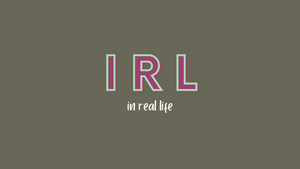A few years ago, social media had an epiphany. The vast network had finally realized that it is not the same as real life! Social media users were flooding this euphoric realization on various platforms. There was no dearth of hilarious and relatable content on how we fake or exaggerate it on social media when we’re totally the opposite in real life.
It was an “In Real Life” movement of sorts. Everyone was coming out of the social media construct we previously followed and propagated so religiously. The ‘no make-up look’ was a new celebration. ‘On social media and IRL’ was another viral meme format that was making us all comfortable and uncomfortable at the same time.
This fashionable realization that social media was indeed a filtered projection of someone’s personality or reality was not the beginning of the ‘In Real Life’ acronymic slang. Neither was IRL the product of such an epiphany. So, where did IRL come from? How old is it? And what caused the slang’s emergence?
IRL — The Rift in Reality
Much before IRL’s appearance in the current social media platforms like Instagram, Snapchat, and Twitter, IRL was an active player in the old-school social networking spaces as well. Users would apply IRL to express the existing difference between social media and real-life even on platforms like Yahoo, MySpace, and AOL.
IRL has been part of our vocabulary since the 1990s or even the 80s. Social media helped speed up the distinction but it didn’t birth the slang. The acronym, when looked closely, says something peculiar. It strikes a clear disparity between real life and aspects of real-life life that aren’t included IRL. It’s a strange concept, tbh.
Media plays a major role in this difference. When we witness something via a third party, aka media, there’s a crack in our perception. That crack is either the radio, a newspaper, the TV, photos, or in today’s context; social media. We’re viewing real people, real things, real events, but, without first-hand experience — virtually and almost fictionally.
We’ve seen how the Avengers are, but we haven’t seen them IRL. We’ve witnessed something and it’s part of our living memory, but at the same time, we are oblivious to its real-life essence. When something is not IRL, we sense it and we try to live it with imagination. But when something’s IRL, there’s a whole new relatable quotient with the subject or subject matter. Even if briefly, there’s a filterless moment — when we see something or someone for what or who they truly are without the filter of media. We finally see and connect in a real manner — thus, the profound IRL acronym.
The Social Media Paradox
Social media, in itself, is a paradox many times. This is in strict reference to viral trends like the ‘IRL’ sensation that was everybody’s favorite a couple of years ago. We celebrate social media filters of perfection, to look great, have a great work record, showcase great parts of our lives that we cherish for everyone to consume — all while making viral alerts that all those parts are not real life. Which is true.
Real-life is a rollercoaster and social media is a mirror maze. It’s only as good as you’d want it to be. Social media is not real life and vice versa. These social platforms are simply navigators and galleries containing the highlights of our lives. We’re beings who love talking about ourselves — that’s just in our nature.
When we leverage social media to share ‘real life’ incidents and glamorous glimpses from otherwise mundane ‘real life’, we also make a clear distinction between our own social media content and RL (a shortened version of the slang). We say that ‘that is not me, but this is SO me IRL’. It’s funny, strange, but also true that social media is and is not. It is real life, but also it’s not because things are not so IRL.
How to Use IRL?
IRL makes an appearance each time there’s virtual interjection in real life. In other words, the acronymic slang can appear when there’s a reference to real life in the context of something virtual. It could be in the context of photography, moving pictures, social media, music, anything that translates and transports something without actual, tangibility. Here are some ways you can use IRL online.
When something’s too good to be true
Most of us are pros at killing the vibe when presented with information that’s simply too unreal to be real. It could be references to movies, celebrities, politics, books, or even parts of other people’s lives — which in fact, is glamorous even IRL.
This is an insecure and pessimistic streak, firstly. But, if it’s justifiable — you could use IRL to make your statement. For example:
- Damn. What a cheesy movie, dude. Why did you ever ask me to watch it?
Come on! It’s such a cute flick!! Look at those two!
It’s cute coz it’s on TV. Love never happens like that IRL.
Gee. Would you chill? It’s just a movie. - Such horrid portrayal of the female body. Name three women who look like that IRL, please?
Can’t think of any, sis.
SMH. Pathetic. What do those girls even eat to sustain??!!
I guess they just hire a photoshop artist.
While referring to something out of the virtual context
If you’re talking about someone or something that’s on a screen and either questioning or wondering what they or it will be like in real life, go ahead, and strike the IRL. Like, ‘She has such great hair, man. Wonder what she does to get it like that IRL!’, *referring to a comic character* ‘Sometimes I fantasize what he’d be like if he were IRL’, or ‘Guess what? I met the creators of that YouTube channel IRL!!!!’.
While responding to or reusing relatable content
One of the more favorite use-cases for IRL is #relatable content. But, there’s one important criterion — the content has to be virtual. It doesn’t make sense otherwise. So, if you’re replying to a relatable meme, responding via commentary or texts to something relatable, or sending relatable content to someone, you can use IRL.
- OMG. This meme is SO you IRL.
- This cartoon’s face was me IRL when you got suspended.
- NGL, but mum is exactly like this IRL.
- I’m totally this panda IRL.
On-screen and IRL
This is a famous and interesting format of celebrity-focused content that attracts quite a lot of traction. It is exciting to see how a character looks in real life as a real person after watching them on-screen. Alongside using IRL for celebs of visual entertainment, you can also use it while referring to media personalities in other sectors.
For instance, ‘___ looks exactly like her character IRL. What’s going on??’, ‘He may be a nice fit for the show, but seriously, he’s not so nice IRL’, or ‘Popular actors and how they look IRL’. This is a niche, particularly for those interested in creating and consuming pop culture news.
Reality checks
Fiction is not always close to reality. Most times, it’s nowhere close to it. If you’re calling out the obvious distinction between fiction and non-fiction, sharing hilarious content about how different things are IRL, or if you’re simply giving someone a reality check, use IRL.
- Those fancy clothes are just too funny IRL.
- But, girl. That’s a TV show for crying out loud!!! Things aren’t that way IRL!
- Life doesn’t work that way, love. Karma exists, but we don’t know it until it hits us IRL. We don’t live by a movie script and life is pretty uncertain, sadly.
- Why don’t we look like this IRL?
We edited our photos before sending them.
Ah. Right. Silly me
Conclusion
IRL is a simple internet slang that refers to real life, as we know and live it. It surfaces a crucial difference between real content on virtual platforms and real life. IRL is the defining acronym for so much about human society in the past 100 years.
We’ve created a virtual reality and thus, this rift between real-time and pre-set schedules. To ease things, we also created an acronym like IRL to refer to the reality that’s real, tangible, and non-fictional. In the present scenario, the slang does help quite a bit while talking about day-to-day, ordinary lives on otherwise filtered, and unreal platforms.










Member discussion